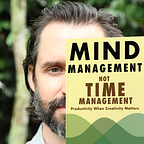Productivity hack: Do nothing.
Listen to an audio version of this post >>
There’s a productivity hack that will improve the quality of your work. You can do it anywhere, you can do it anytime.
You can do it in the waiting room at the dentist. You can do it on a plane. You can do it while your dinner partner is in the bathroom.
I guess I gave it away with my title, but it’s called “nothing.” Do nothing sometimes. It’s good for you.
Doing nothing won’t improve your productivity if your job is making pre-designed widgets. Then you just have to make widgets really fast. You should probably make widgets while your friend is in the bathroom — if your widget-maker will fit on the dinner table.
Chances are you don’t make widgets. You have to understand problems, invent solutions, and invent ways to implement those solutions. Sometimes you even invent the solution before you know the problem. All of these things are helped by doing nothing.
Doing nothing is in a category of activities psychologists call incubation. Incubation helps you solve insight problems.
Insightful thinking requires letting disparate thoughts in your brain collide together. Think of a racquetball court with blue racquetballs bouncing from corner to corner by their own volition. Eventually some of them will collide.
Now, if you drive a big giant truck into that racquetball court, the balls aren’t going to collide so easily. They’ll just thud off the metal sides, and roll around the floor a bit until they run out of energy.
The things most people do when they could be doing nothing are like driving a big giant truck into their racquetball courts: Constantly consuming snacks of information, checking Facebook (then Twitter, then Facebook), or listening to music.
In the words of Alanis Morissette, “Why are you so petrified of silence?”
HOW TO DO NOTHING
- Wait for a time when you are idle: on the bus, or standing in line, for example.
- You will feel a tinge of anxiety that makes you want to do something. Just let it pass. For entertainment, you can examine that feeling. Say to yourself “ohhhh, that’s interesting.”
- Your neck might feel funny because it isn’t craned down toward your phone. If you are in a public place, someone might accidentally make eye contact with you. Don’t panic.
Doing nothing is hard at first, but if you get good at it, you don’t even have to wait until you are on a plane or dining alone. You can actually choose to do nothing in the comfort of your own home.
The instructions are the same as above, but there are likely more options for things you could do, so this is an advanced technique.
Unless you work for yourself, I recommend against doing nothing at the office, though that can also be useful.
The more you try doing nothing, the more you’ll find opportunities to do nothing. When you finally get around to doing something, you’ll do it better.
Neuroscientist John Kounios studies the science of “Aha!” moments. Listen to the podcast episode in which he explains the ideal conditions for insight.
This article also appeared on Quartz.
